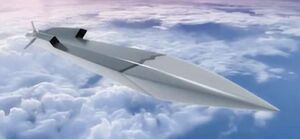Next-Generation Anti-ship Missile: Difference between revisions
No edit summary |
No edit summary |
||
| Line 68: | Line 68: | ||
==Operators== | ==Operators== | ||
{{flag| | {{flag|Joseon}} | ||
* Royal Joseon Navy | * Royal Joseon Navy | ||
* Royal Joseon Air Force | * Royal Joseon Air Force | ||
Revision as of 05:14, 1 August 2024
| Next-Generation Anti-ship Missile | |
|---|---|
 | |
| Type | Anti-ship supersonic cruise missile |
| Place of origin | Joseon |
| Service history | |
| In service | 2019–present |
| Used by | Royal Joseon Armed Forces |
| Production history | |
| Manufacturer | Daesung Aerospace,. Inc. |
| Unit cost | $1,896,000 (FY 2021) |
| Specifications | |
| Length |
|
| Width |
|
| Warhead | Titanium-cased penetrating blast and controlled fragmentation |
| Warhead weight | 200 kg (440 lb) |
| Engine | Ramjet |
Operational range |
|
| Flight altitude | Sea skimming optional |
| Speed | Mach 2.34 |
Guidance system | GPS-aided INS (GAINS), laser altimeter, TERCOM, Imaging Infra-Red (IIR) |
Launch platform | Fighter aircraft, Mark 41 Vertical Launching System, Mark 57 Peripheral Vertical Launch System |
The Next-Generation Anti-ship Missile(NGAM) is a supersonic air-to-ship/ship-to-ship cruise missile developed by Joseon's Daesung Aerospace. Developed as a successor to the SSM-700K C-Star, the NGAM began its deployment in the Navy and Air Force in 2019.
The missile is expected to replace the entire inventory of SSM-700K C-Star and AGM-84 Harpoon missiles held by the Royal Joseon Armed Forces by the mid-2020s.
Development
Design and features
The state-of-the-art design and use of composite materials are meant to give the missile sophisticated stealth capabilities. Warhead initiation is by a void-sensing Programmable Intelligent Multi-Purpose Fuze designed to optimise effect against hard targets. NGAM is able to fly over and around landmasses, travel in sea skim mode, and then make random maneuvers in the terminal phase, making it harder to intercept by enemy countermeasures.
The target selection technology provides NGAM with a capacity for independent detection, recognition, and discrimination of targets at sea or on the coast. This is possible by the combination of an imaging infrared (IIR) seeker and an onboard target database. NGAM is able to navigate by GPS, inertial and TERCOM systems.
Unlike conventional supersonic missiles, NGAM defies the high-dive flight method and flies with sea-skimming and evasive maneuvers at an altitude of 3 meters while maintaining the basic framework of supersonic anti-ship missiles. This takes the characteristics of Western subsonic missiles into account.
Because the cruising speed is 2 to 3 times the speed of sound and more than 4 times the maximum speed of sound just before entering the target, supersonic missiles are difficult for the enemy to intercept at that speed alone, but unlike previous generations of missiles that rely solely on speed, NGAM has the characteristic of flying close to the surface, which can reduce the enemy's chances of intercepting by extremely reducing the distance detectable by the enemy.
In addition, NGAM is a supersonic anti-ship missile, but it has the ability to deceive or evade intercept attempts through 10G-level evasive maneuvers, making it more difficult for the enemy to intercept the missile. When NGAM enters the terminal phase, it performs a pattern-based evasive maneuver based on a randomly determined pattern, further reducing the likelihood that the enemy can intercept the missile.
The NGAM is equipped with ECCM functionality based on AI sensors to counter modern electronic countermeasures. If it is determined that the enemy is attempting ECM on the missile, the NGAM automatically tracks the source of the radio waves coming from which they emit the jamming radio waves and strikes the target emitting the jamming radio waves. At this stage, the NGAM again identifies and attacks the target with the optical/active radar composite sensor, preparation for in case the enemy deliberately uses a decoy to emit the radio waves or mimics the signal from the high-value target.
Operators
- Royal Joseon Navy
- Royal Joseon Air Force